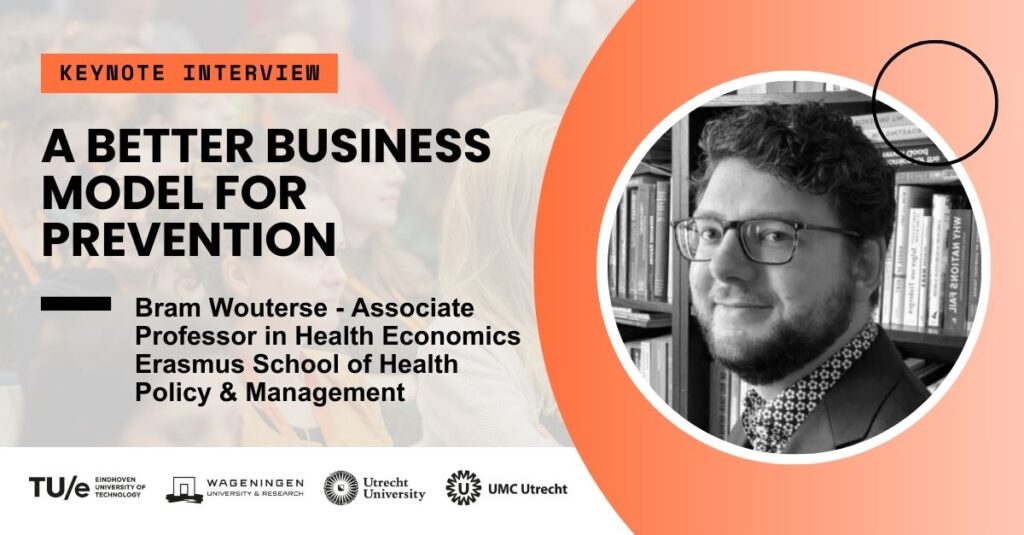By Annemieke Groenenboom
The willingness to pay for preventive measures is limited; the benefits often don’t return to the investor. Health economist Bram Wouterse sees potential in alternative financing models. “Don’t focus solely on health outcomes; align with the interests of others, such as employers aiming for sustainable employability.” He will present his vision and insights at the upcoming annual Preventive Health Conference.

“Preventive interventions are often developed with a narrow focus on health perspectives and available technologies,” says Bram Wouterse, Associate Professor of Health Economics at the Erasmus School of Health, Policy & Management. “For instance, numerous apps are created to combat obesity, including for use in companies, but is that really what employers want? “If they’re dealing with significant levels of absence, they might prefer an app focused on sustainable employability or obesity interventions as part of a broader program. Those who take the time to understand others’ interests in advance can design more effective interventions that people are actually willing to invest in.”
Cost-Effective Investment in Health
“The search for alternative forms of funding is urgently needed,” continues Wouterse. “The willingness to pay for prevention is particularly low due to the imbalance between the investor and the recipient. A municipality that invests in preventive measures gains healthier citizens in return, but this isn’t immediately reflected in its balance sheet.”
”The willingness to pay for prevention is particularly low due to the imbalance between the investor and the recipient.”
“Furthermore, the available healthcare budget is primarily spent on curative care, as established by the Health Insurance Act [ed. Zorgverzekeringswet]. Preventive interventions fall outside this scope and must be funded from other funds with different purposes, creating competition. Additionally, prevention doesn’t always lead to lower healthcare costs. A long and healthy life that ends in a nursing home can cost just as much, if not more, than a shorter life with many health complaints. We need to view prevention more as a cost-effective way to invest in health, and less as a means to reduce healthcare costs.”
Willingness to Pay
Wouterse calls for research into where the benefits and willingness to pay actually lie. “In addition to employers, you might find it with municipalities, health insurers, or food companies. For example, we know that a tiered sugar tax works well. Each tier represents a specific amount of sugar per liter of soft drink, and that amount is taxed. Soft drink manufacturers respond to such a tax by reformulating their products to stay just below a certain tier. From a health perspective, you might disapprove of this, but it does lead to less sugar in soft drinks. Moreover, it’s more effective than a general price increase that the consumer ultimately pays.”
A Broad, Creative Perspective
“A broader perspective requires creativity and the willingness to explore other fields of expertise. This is exactly what the Institute for Preventive Health encourages through interdisciplinary and transdisciplinary research, and it would be great if we could involve practice more in this process. Think of citizens using the interventions, or health insurers and municipalities funding them.”
”A broader perspective requires creativity and the willingness to explore other fields of expertise.”
According to Wouterse, research design should also place more emphasis on financing options and scalability: “It’s also about how you organise it and with whom. For example, the Combined Lifestyle Interventions (GLI) program for people with overweight and obesity has been successful in this regard. It’s included in the basic insurance package, making it legally obligatory for health insurers to reimburse it. Another (commercial) example is the IZZ collective, which offers health insurance for healthcare workers. They cater to the interests of healthcare employers by focusing on investing in workplace relationships and reducing pressure on healthcare services.”
The Right to Health
Wouterse: “Of course, adopting a broader perspective isn’t just for researchers. All stakeholders have a role to play. For example, policymakers could establish a national fund to finance proven effective interventions. Or consider more compelling measures, such as legal health targets. Policymakers and other stakeholders would then share responsibility for these targets—and for the associated investments. Insurers could also consider a new role. Strictly speaking, they currently have no role in health promotion, only in reimbursing healthcare costs.”
”Right now, we have the right to healthcare, but not to health—and that really needs to change.”
“In short, there are plenty of opportunities, but we need to turn them into action. We spend more money on healthcare each year. Because most of this is allocated to curative care, such as medical and technological treatments, we are able to treat more and more effectively. However, this leads to rising healthcare costs. Does such a system ultimately result in better health? Right now, we have the right to healthcare, but not to health—and that really needs to change.”